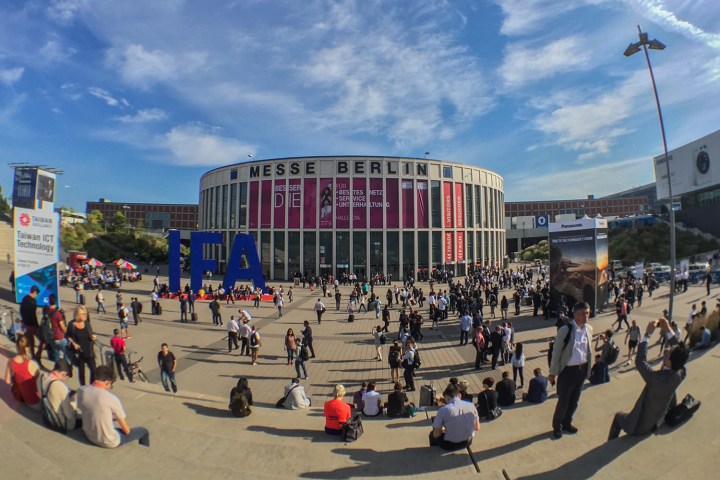
Mid-range phones cost too much

We haven’t seen many flagship phones at IFA this year, but there have been some interesting tablets. The smartphone field has been distinctly mid-range; the specs war may be ending. Most smartphones have surpassed the point of “good enough” performance.
Despite the lack of cutting edge processing power, the trend of premium metallic finishes shows no signs of abating and, we’ve lost count of the number of times a chamfered edge was described as diamond-cut. The companies behind these phones obviously want them to be perceived as affordable flagships with premium builds (like an iPhone or Galaxy). But they just as often feel like adequate phones that cost too much. While it’s good to see quality increase across the board, it’s becoming more difficult to find the true bargains.
The smartwatch has come full circle

The watch has come full circle (literally), and rectangular smartwatches are out. Apart from the Apple Watch, that is – and its square shape is starting to look, well, square.
Companies like Samsung and Asus started their smartwatch journey with rectangular devices a few years ago, but they’ve since made the shift to a more traditional wrist-piece. Case in point? The Asus ZenWatch 3, Asus’ first flagship watch with a circular design. Expect to see more circular watches as we head into the holiday season — and don’t expect to see many (or any) rectangular ones.
Intel’s 7th-gen chips are inspiring new laptops

Core, Intel’s main line of processors, is now on its seventh generation. The first examples of the new hardware arrived at IFA 2016, and they are paving the way for an estimated 250 designs that are scheduled for release before the end of the year.
Those designs are targeting the back-to-school, and then holiday, buying seasons. Because Intel is launching 7th-gen mobile dual-core chips first, you’ll see new designs focused there, and in particular in the high-end market. The next few months will be a good time to buy a laptop.
Every laptop is a 2-in-1

Acer’s headline PC at IFA 2016 was the Spin 7, the thinnest 2-in-1 yet produced. But it wasn’t alone. The company announced a full line of Spin devices ranging from the budget Spin 1 up to the $1,200 Spin 7. Lenovo, too, announced affordable and attractive 2-in-1s, like the $550 Yoga Book with Windows and the $600 Miix 510. In fact, every PC announced by Lenovo was a 2-in-1.
It’s not clear that users demand 2-in-1s, but it’s also not clear that demand matters. As the technologies that power the category become easier to produce, and more affordable, manufacturers are finding new value in multi-use PCs. Like the ultrabook before it, the 2-in-1 is likely to become more or less standard. You’ll likely find yourself buying one, whether you want a 2-in-1 or not.
Eye-tracking is gaining popularity

Have you heard of Tobii? If not, we don’t blame you, though we have covered them for half a decade. The company, which has an eye-tracking technology designed for unique user input, has been around for a long time. Now, Tobii is starting to hit its stride. Its hardware has appeared in a new line of Acer Predator monitors at IFA 2016. It’s also in mobile hardware from Alienware and MSI, among others.
That list of products might make you think Tobii is all about gaming. But it’s also useful for Microsoft’s Windows Hello login utility – and that may in fact become its killer app. And it’s not just Tobii in this field. Intel’s RealSense is just as capable. It seems these solutions have finally found their problem.
Everyone wants a slice of VR

Everybody wants a piece of the VR pie, and IFA couldn’t have made that more apparent. It’s not just Oculus and HTC’s arena anymore.
In just the first couple days of IFA, we’ve seen a handful of companies — Qualcomm, Alcatel, Acer, and a few others — either showing off new gear or announcing prices and availability for headsets they’d previously revealed. And that’s just the headgear side of things. Once the floor opens up, we fully expect to see a smattering of VR software and peripherals. The VR bandwagon still has plenty of room for people to hop on board.
Awesome tablets are back, but do we still want them?

Tablets, or more precisely, tablets we may be tempted to buy, aren’t dying as fast as some may have predicted. Huawei and Lenovo in particular have excelled with tablets this year, with the MediaPad M3 and Yoga Book both really impressing respectively, and honorable mention also goes to Asus and the ZenPad 3S. Companies have seen the value in making tablets that can actually do some computing, finally giving the iPad some meaningful competition.
The question is, are we bored of tablets, regardless of whether they’re good or bad, cheap or expensive, thanks to phones with massive screens?
Robots want to help you cook

IFA is packed with appliances, but one trend that’s stood out is guided cooking. Whether it’s Sharp’s Love2Cook, a smart oven that’s preloaded with recipes; Bosch’s non-connected multicooker with accompanying app; or Samsung’s upcoming debut of its Club des Chefs app, where Michelen Star chefs will guide you through the cooking promise, everyone wants to make sure you don’t mess up in the kitchen.
The message seems to be you don’t need to be a master in the kitchen to make good food. Take AEG Electrolux’s SenseCook. You don’t even have to know what temperature to cook your steak! Just dial in the level of doneness, and the included probe keeps track of when it’s time to stop cooking. Even kitchen appliances that aren’t connected are getting smarter.
Tech companies are having an identity crisis

Once upon a time it was enough to hang your company’s reputation on the quality of its products, but if the press conferences at IFA 2016 are any indication, that’s no longer the case. While it’s typical for large corporations to spend several minutes updating the public on how they are striving to innovate and remain competitive in the marketplace at these events, this year it seemed like half the time these companies had our attention was spent on a reaction to some sort of identity crisis.
Panasonic told us about how it wants to save the world with clean energy and “smart cities;” LG toured groups through an elaborate art installation which symbolically related products to natural phenomena; Samsung made a point of showing off how it was providing jobs to European millennials floundering in a struggling economy; and Sony continues to hammer home the nebulous concept of “Kando” as the basis for its product development.
Philanthropy and artistic endeavors are fine and good, but they always feel a bit hollow when used to sell products.




